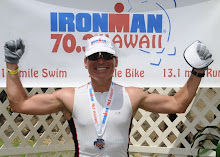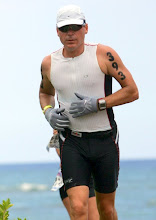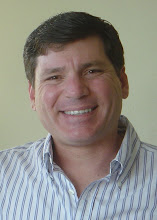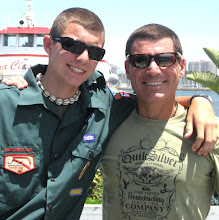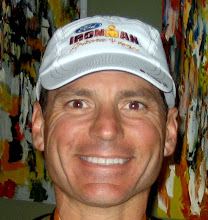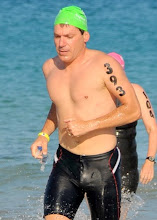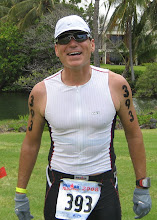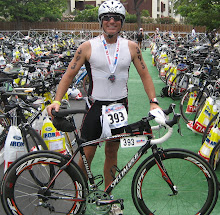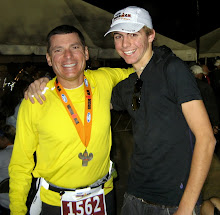Well my luck recently ran out....I was hit by a car while on my bike.
I was traveling about 16 mph and was broadsided or "T-Boned" by a very young lady making a left hand turn into a side street. She tried to merge between oncoming traffic and was so focused on the traffic that she did not see me coming in the bike lane.
It was a complete accident and I am not upset with her nor harbor any ill-feelings toward her. Accidents happen and I am just thankful and elated to be alive. Period.
I was just minding my own business and clearly in the bike lane. But there was nothing I could do; there was not even time to try and brake. The moment I saw the car was the exact same moment I saw my bike get pulled under her bumper. There was zero time to react.
I hit the hood of the PT Cruiser, rolled off and according to witnesses, rolled side over side 15 - 20 times, shoulder to shoulder, somehow settling face-down on my stomach on the sidewalk. Remarkably, my Oakley Radar sunglasses were still attached! The one thing I remember was this uncontrollable rolling and rolling.
I just lay on my stomach for a long time trying to process what had happened. I did not want to move anything and instead, did sort of a mental checklist on every part of my body before I decided to try and move. I did not feel any pain at that moment and that really worried me.
Had I severed my spinal column? Was I paralyzed? I was too scared at the moment to try and move. I didn’t want to know.
So many people were gathered around and asking me so many questions at the same time that it was hard to process anything.
People kept scouring the street bringing me pieces of my bike and piling them up next to me; I do remember that part. I also remember people asking me, "Who is David? Who is David?"
Apparently, I kept saying that David will see the workout data and I have to finish the workout, this is the most important workout of the year and my last major brick workout prior to the full Ironman. David, of course, is none other than the world-famous David Warden, my triathlon coach who took me on as a charity case about a year ago. (Check him out at www.tri-talk.com, listen to his Podcasts on iTunes and look for his upcoming book. He is quite literally, the world's leading expert.)
I was at about mile 90 of my ride when I was struck at about 3:35 pm. The day called for 112 miles or 6.5 hours on the bike, whichever came first, then an additional run for 1.5 hours.
The scene was surreal. About 50 spectators, an ambulance, police cars, a fire truck, paramedics and the Harbor Patrol. That’s a lot of tax payer dollars at work!
The great news, in fact, the miraculous news, is that I barely have a scratch. There are hardly any external signs on my body that I was hit by a car at that speed.
It was a cold, foggy morning in Carpinteria and as I set out from our beach house, I decided to wear three, yes THREE, long sleeve shirts, a full set of fingered gloves and also my bike gloves. All these extra layers were 100% responsible for saving my arms, hands, back and elbows from certain road rash. The outer bike jersey was really ripped up, but it took the brunt of the asphalt abrasions. The other layers prevented any abrasion at all to my skin. It really was miraculous. And lucky. Sort of like wearing two pairs of socks for long runs in order to avoid blisters; those extra layers really make all the difference.
Fortunately, my feet sprang out of the toe clips pretty fast, as the car smashed the bike right out from under me and I was immediately released; the toe clips did their job and I have no twisted ankles or broken bones in the lower legs, ankles or feet. In fact, I barely have a scratch on the lower legs despite being thrown, hitting the hood and rolling about 20 - 30 feet. Just amazing!
To be clear, as I was told the story by the eyewitnesses, I more “rolled” than was actually thrown. Rolled off the hood, rolled down the street, etc.
My bike helmet stayed on and my head was not hurt, but my neck is really sore and very stiff today and my shoulders ache from taking the brunt of all the rolling. It has now been about two days since the accident.
The first-responders were the witnesses and they were fantastic, they included a male nurse and a middle-aged man who saw the whole thing happen right in front of him as he and his friends were in the car waiting to make a right hand turn. He was shocked that I was alive and breathing and he took great care of me. I wish I had his name to thank him personally. He kept me calm and was upbeat.
I’m not too proud to readily admit that I was a bit scared. I really did not want to know how bad the injuries were. I just wanted to lay there for a few minutes and process this all mentally before I took any physical action to check for injuries.
The bike was really trashed. Bits and pieces of carbon and my PowerTap power meter, broke off. The brake/shifter combo is thrashed and my Zipp 606 high profile carbon rims may be cracked. My Look Carbon-Titanium pedals were ground down from the bike sliding and bouncing on the asphalt and my rear derailleur was severely bent. Most disappointing, however, was the Specialized S-Works Roubaix SL2 Carbon frame, which took a direct hit, broadside and got smashed by the car.
I did not want to accept any medical attention for fear of the costs. I know it sounds stupid at this point, and I do have medical insurance, but about 18 months ago my wife needed to use emergency treatment when she contracted West Nile from an infected mosquito and hardly anything was covered. Despite all of our insurance coverage, I was paying for all kinds of additional "non-covered" tests, procedures, drugs, etc. for months and months! It even got to the point that they threatened to ding my credit over a dispute over the ambulance charges which were obviously and so clearly over-inflated. All these additional bills kept showing up out of nowhere. Doctors I never heard of, never met, never knew were involved were sending us bills. It seems that all the extra tests that the hospital ordered were not covered and I had to pay for all of those as well. The ambulance ride, everything. So I was not going to go through that again!! I tried to stand up (it took two attempts, as I was still a bit wobbly) and I was able to answer the basic questions that the paramedics ask to see if one might have a concussion. They let me go ahead and refuse the ambulance and I thanked them for that!
That does say something about our insurance system, doesn't it?! Guy takes a direct hit by a car but does not want to be checked out, even though he has insurance, all due to a bad experience with constant bills from a recent event where hardly anything is covered at all. But that's another issue and my good friends at The Regence Group, a BlueCross and BlueShield health care company with excellent leadership, is working hard to change. Regence is committed to change our national health care system to give us all more choice and power in directing our health care. They are the real deal and I have every confidence in their ability to change the way we all access health care. Look them up online at www.Regence.com.
Back to the story...
A fellow triathlete who had witnessed the accident begun re-assembling what was left of my bike and putting things back in order so we could see what was going on. He was very concerned that I should not ride the bike, as he was certain that the carbon frame was cracked from the direct hit of the car and going under the bumper. But nonetheless, he did a great job reassembling things and I am very grateful. I was very worried about the bike. (All told, I think there is $10 - $12K tied up in that machine!) The wheel set was crunched and bent, but by releasing the brake calipers, he was able to get the rims to spin just enough to miss the brake pads and to get the bike back on the road.
While I was struggling to figure out what exactly had happened and was still face down on the ground, someone saw the chain on the back of my neck and reached into my shirt to grab my “Road ID” dog tags and called my business partner, who then called my wife. She tried to call, but I never knew it because my cell phone was crunched and fell apart in the accident! But some guys put it back together for me while they were gathering up all my stuff from the street, and the first call was from my wife.
I will never forget her first words.....
"I'm coming to pick you up. It's OVER!!!"
I didn’t know exactly what “It’s OVER!” meant. Today’s ride? My training? This whole Ironman dream? Biking on the streets? Whatever it meant, I could tell that she was pretty damn serious and more than just a little upset.
I said, "I am fine, and even though my bike is ruined, I have to try and finish the workout! Don't come! I will see you in about 45 minutes, but I have to try and finish the workout. This is the most important workout of the year."
I had a funny feeling that my wife was coming up and that she'd track me down, so I had to plan a quick exit.
I thanked everyone profusely because I was so genuinely happy to be alive; crazy as it seems, I was smiling broadly, just so genuinely happy that I was not seriously injured, or worse.
I tried to act manly and tough for some reason, sort of like I had an obligation to live up to the Ironman name and reputation of pushing through the pain; ignoring pain. I had a standard to keep and was representing all Ironmen worldwide. I can’t explain it, but I would think that other Ironmen might understand.
I grabbed three Tylenol from a stranger, downed them quickly with my energy drink and took off VERY slowly in the opposite direction of home; the wheels were wobbly and the gears could not shift due to the broken derailleur and the jammed/bent brake/shifter lever, but I was going to try and finish my workout. This could happen in the Ironman event, I could get banged up in a bike accident during the event and I would still have to find a way to finish, so this would just be another test!
Time must have been going in very slow motion (plus I couldn’t shift gears!), but before I knew it, my wife and son had driven all the way up to Santa Barbara from Carpinteria and found me limping down the road.
She drove her new Range Rover right next to me and told me to put the bike in the back of car; I wouldn't do it, but I did stop to talk to her and thank her for caring. I told her the story of what had happened and that I was not injured, but she thought I might have internal injuries or a head injury.
She couldn’t understand why I was so excited and happy, but just to be alive and be OK from that accident made me very grateful and energetic! I smiled broadly for a photo that she could send to my business partner to tell him that I was OK.
She followed behind me, which of course ANY man will tell you is all at once: embarrassing (ever had your Mother follow you home on your bike as a kid!!), exciting (to try and beat her home with only one gear and half a brake), and endearing (to know that someone actually cares).
As soon as I arrived home, I started making my plans for the 1.5 hour run. I changed my clothes and got into the running gear, fueled up, grabbed my water bottles and was off.
The run was quite difficult as I now had a new fear of cars that I have never had before. Soon it got dark and I was very worried about cars. I am sure that the fear will pass at some point.
I was tired from the 106 mile bike ride and ended up walking and jogging. I was also very hungry. I stopped by a liquor store and bought a bag of chips, some peanut crackers, a bag of salted peanuts, a 5-hour energy shot and a PowerAde. I ate all this while I was running down the road, pulling items one by one from the plastic grocery bag.
I completed the run in total darkness by following the white line on the side of the road.
It was a long day. A lucky day to be sure. I am very grateful that I was not seriously injured and I am happy that I completed the entire workout despite the hurdles and challenges of the day.
If I can finish this workout despite the events of the day, I know that I can complete the full Tempe Ironman Triathlon on November 23, 2008!













